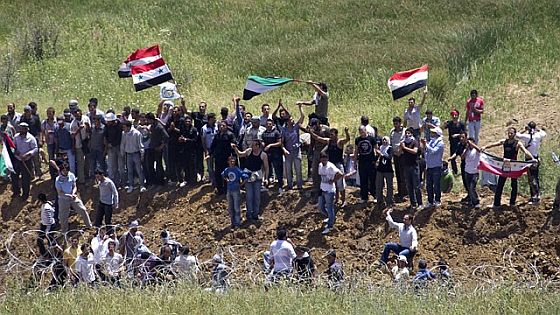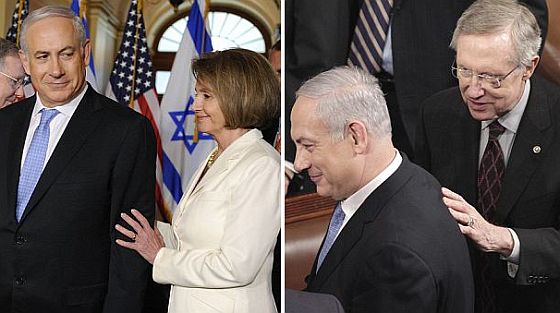Jesse Rosenfeld and Joseph Dana write:
At 10:30 on May 15, two battalions of Israeli combat soldiers opened fire with tear gas and rubber bullets on hundreds of unarmed Palestinian demonstrators at the Qalandia checkpoint dividing Ramallah from Jerusalem, sending people scrambling into the adjacent refugee camp. These were the opening shots of Israel’s response to protests commemorating the Nakba, the Arabic word for catastrophe, used to define Israel’s creation of 750,000 Palestinian refugees in 1948. By nightfall Israeli soldiers had killed thirteen Palestinian refugees and wounded hundreds with live fire on its borders with Lebanon, Syria, Gaza and inside the West Bank.
The May 15 demonstrations reinvigorated the long-alienated Palestinian refugee community; although it is 70 percent of the Palestinian population, it has been largely shut out of the negotiations process with Israel. The emerging unity was on display at Qalandia, where youth trying to symbolically march from Ramallah to Jerusalem wore black T-shirts with the slogan “Direct Elections for the Palestine National Council, a Vote for Every Palestinian, Everywhere.” The PNC is the legislative body of the Palestine Liberation organization and is responsible for electing its executive committee. Traditionally, seat allocation in the PNC has been divided to represent the influence factions within the PLO, of which Hamas is not a member.
The Nakba protests have been the largest so far of a growing Palestinian youth revolt. The protests—launched with unity protests on March 15 in the Palestinian Authority–controlled West Bank and Hamas-governed Gaza Strip—are the Palestinian response to the outbreak of revolutions in Egypt and Tunisia. While it is a new development, this manifestation of popular anger against Palestinian Authority concessions in the failed negotiations process—shockingly revealed with Al Jazeera’s January release of top-secret negotiation minutes, known as the Palestine Papers—and Israel’s practice of divide and rule has been simmering under the surface for the past three years.
“The unity agreement between Fatah and Hamas gave people hope to be here today and continue with this new phase of struggle,” said Fadi Quran, a founding organizer of the March 15 movement, amid the clashes with Israeli soldiers at the Qalandia checkpoint. “It showed us that something was possible and we must continue,” he added, coughing from tear gas.
Peter Beinart adds:
I watched Benjamin Netanyahu’s speech to Congress with a guy named Fadi Quran. He recently graduated from Stanford, where he double-majored in physics and international relations. He lives in Ramallah, where he’s starting an alternative energy company. And he just might rock our world.
Quran is helping to coordinate a raft of Palestinian youth organizations—located in the West Bank, Gaza Strip, Jordan, Lebanon and Syria—all united around one goal: to create a Palestinian Tahrir Square. They organized the unity march that helped pressure Fatah and Hamas to reconcile. Ten days ago, they organized the Nakba Day protests in which refugees marched on Israel’s borders.
What they’re doing isn’t exactly new. Palestinians in the West Bank have been conducting regular nonviolent protests for many years now, often against the separation barrier that stands between them and their fields. But Egypt and Tunisia made Quran and his colleagues realize that nonviolence was possible on a much larger scale. Not everyone in his movement believes in peaceful resistance as a matter of principle, he admitted sheepishly. But they all believe it represents the right strategy. They’ve been studying the civil rights movement and Gandhi’s struggle against the British and the movement that peacefully brought down Slobodan Milosevic in Serbia. No one wants a second intifada, he insisted. “It hurt us much more than the Israelis.”
When I asked Quran what his movement believes, I expected to hear about borders and refugees and Jerusalem. Instead, he began talking about John Rawls and John Locke, a social contract between the government and the governed. A Palestinian government that denies his rights, he insisted, is as offensive as an Israeli one. When I pressed him on whether his colleagues want two states—one Palestinian, one Jewish—or a secular binational one, he seemed strangely agnostic. He said that in an ideal world one democratic state would be better, before adding that of course such a state would have to guarantee the safety and cultural autonomy of Jews. (One of his inspirations, he said, was Martin Buber, the Jewish philosopher who advocated a binational state in the 1920s and 1930s). When I said I didn’t consider a binational state very realistic, he conceded the point, before noting that in the age of Netanyahu and Lieberman, most Palestinians don’t consider a two-state solution very realistic either.




